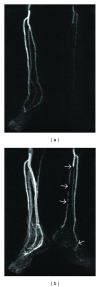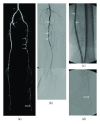TRICKS magnetic resonance angiography at 3-tesla for assessing whole lower extremity vascular tree in patients with high-grade critical limb ischemia: DSA and TASC II guidelines correlations
- PMID: 23304080
- PMCID: PMC3529896
- DOI: 10.1100/2012/192150
TRICKS magnetic resonance angiography at 3-tesla for assessing whole lower extremity vascular tree in patients with high-grade critical limb ischemia: DSA and TASC II guidelines correlations
Abstract
The entire vascular tree of 58 lower extremities with high-grade critical limb ischemia (CLI) was assessed with three-station time resolved imaging of contrast kinetics (TRICKS) magnetic resonance angiography (T-MRA) and correlated with digital subtraction angiography (DSA) examinations and Trans-Atlantic Inter-Society Consensus II (TASC II) guidelines. Kappa (κ) statistics were utilized to evaluate the agreement of stenosis scores (5-point scale; 0 normal to 4 occlusion) based on T-MRA and DSA. With DSA as the standard, significant stenosis instances (stenosis score ≥2) among vascular segments were compared. The κ-statistics of image quality (4-point scale; 1 nondiagnostic to 4 excellent) of T-MRA and TASC II classification assessed by a radiologist and a vascular surgeon were also evaluated. Among 870 vascular segments, excellent agreement was observed between T-MRA and DSA (mean κ = 0.883) in revealing stenosis (mean stenosis score, 2.1 ± 1.3 versus 2.0 ± 1.3). T-MRA harbored overall high sensitivity (99.5%), specificity (93.6%), positive predictive value (95.4%), negative predictive value (99.6%), and accuracy (97.7%) in depicting significant stenosis. Excellent interobserver agreement (mean κ = 0.818) of superb image quality (mean score = 3.5-3.6) of T-MRA and outstanding agreement of TASC II classification of aortoiliac and femoral-popliteal lesions (κ = 0.912-0.917) between two raters further verified the clinical feasibility of T-MRA for treatment planning.
Figures



Similar articles
-
Clinical utility of time-resolved imaging of contrast kinetics (TRICKS) magnetic resonance angiography for infrageniculate arterial occlusive disease.J Vasc Surg. 2007 Mar;45(3):543-8; discussion 548. doi: 10.1016/j.jvs.2006.11.045. Epub 2007 Jan 16. J Vasc Surg. 2007. PMID: 17223303
-
Non-contrast-enhanced MR angiography in critical limb ischemia: performance of quiescent-interval single-shot (QISS) and TSE-based subtraction techniques.Eur Radiol. 2017 Mar;27(3):1218-1226. doi: 10.1007/s00330-016-4448-6. Epub 2016 Jun 28. Eur Radiol. 2017. PMID: 27352087
-
Evaluation of Quiescent-Interval Single-Shot Magnetic Resonance Angiography in Diabetic Patients With Critical Limb Ischemia Undergoing Digital Subtraction Angiography: Comparison With Contrast-Enhanced Magnetic Resonance Angiography With Calf Compression at 3.0 Tesla.J Endovasc Ther. 2019 Feb;26(1):44-53. doi: 10.1177/1526602818817887. Epub 2018 Dec 24. J Endovasc Ther. 2019. PMID: 30580695
-
Pedal artery imaging--a comparison of selective digital subtraction angiography, contrast enhanced magnetic resonance angiography and duplex ultrasound.Eur J Vasc Endovasc Surg. 2002 Oct;24(4):287-92. doi: 10.1053/ejvs.2002.1730. Eur J Vasc Endovasc Surg. 2002. PMID: 12323169
-
A prospective feasibility study of duplex ultrasound arterial mapping, digital-subtraction angiography, and magnetic resonance angiography in management of critical lower limb ischemia by endovascular revascularization.Ann Vasc Surg. 2007 Jul;21(4):443-51. doi: 10.1016/j.avsg.2006.08.005. Epub 2007 Feb 26. Ann Vasc Surg. 2007. PMID: 17628263
References
-
- Norgren L, Hiatt WR, Dormandy JA, Nehler MR, Harris KA, Fowkes FGR. Inter-society consensus for the management of peripheral arterial disease (TASC II) Journal of Vascular Surgery. 2007;45(1, supplement):S5–S67. - PubMed
-
- Ouriel K, Fiore WM, Geary JE. Limb-threatening ischemia in the medically compromised patient: amputation or revascularization? Surgery. 1988;104(4):667–672. - PubMed
-
- Shareghi S, Gopal A, Gul K, et al. Diagnostic accuracy of 64 multidetector computed tomographic angiography in peripheral vascular disease. Catheterization and Cardiovascular Interventions. 2010;75(1):23–31. - PubMed
MeSH terms
LinkOut - more resources
Full Text Sources
Research Materials
Miscellaneous

